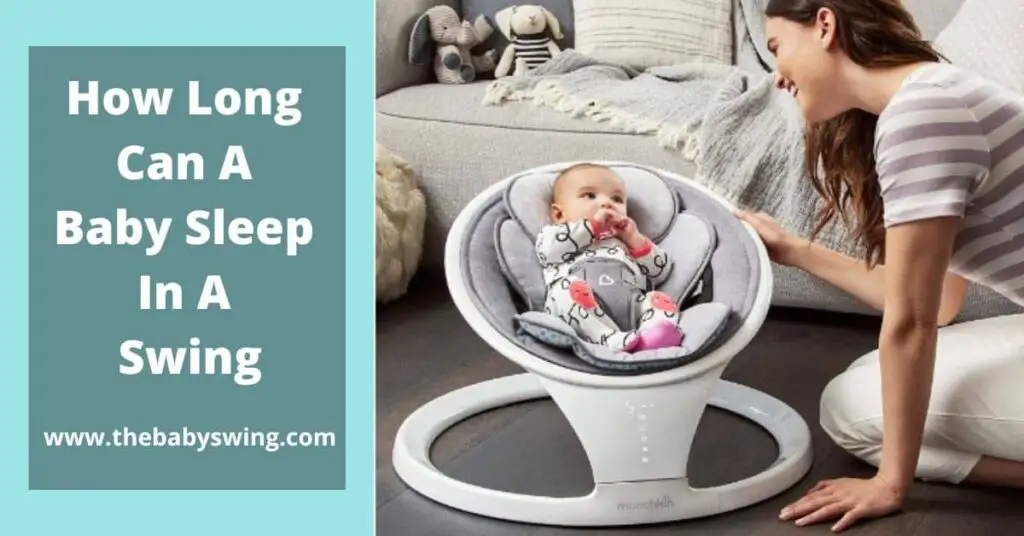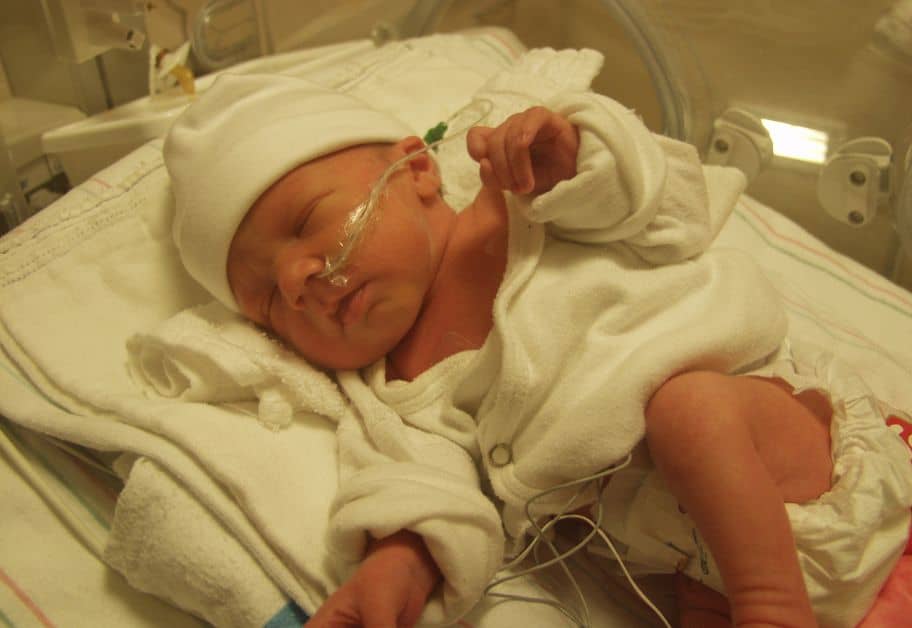Last Updated on July 18, 2023
There’s nothing quite like the sound of a baby sleeping peacefully, and many parents swear by swings as a way to get their little one to sleep. But how long can a baby safely sleep in a swing? And when is it time to move on to something else? Keep reading for answers to these questions and more!
- How long can a baby sleep in a swing?
- Can my newborn sleep in a swing?
- When Do Babies Outgrow Swings?
- The risk of tipping over or falling out
- What are the AAP Safe Swing Use Guidelines?
- Can you put a preemie in a swing?
- Do baby swings have a weight limit?
- Can you overuse a baby swing?
- Is there a time limit a baby should be in a swing?
- FAQ Baby Swing
- Wrap up:
How long can a baby sleep in a swing?

According to APP, a baby should not spend more than 30 minutes in a swing at one time. Heidi Murkoff, a famous writer and the author of “What to Expect the First Year,” said in her book, “You should take your baby out of the swing after 30 minutes and use it only two times in a day.”
You have to use the swing when the baby is awake. You can not put your baby in a swing for a short nap or sleep through the night. The AAP does not recommend that babies sleep in swings for naps or overnight because it might increase the risk of Sudden Infant Death Syndrome (SIDS).
If the baby falls asleep in a swing, you should take the baby out of the swing and put them in a crib or flat, firm uneven surface.
Limiting the amount of time your baby spends in a swing is important because it can cause the flat head syndrome. The flat head syndrome is when a baby’s head becomes flattened from spending too much time in one position.
The American Academy of Pediatrics recommends that babies sleep on their backs to reduce the risk of SIDS, so it’s important to limit the amount of time your baby spends in a swing.
Can my newborn sleep in a swing?
It is not advisable for your newborn to sleep in a swing. Infants haven’t developed their muscles enough to support their heads yet. As babies fall asleep easily anywhere, they might try to take a nap in the swing. If they’re not reclined, they may slump their head forward, blocking their oxygen supply.
If you’re thinking of using a swing to soothe and relax your infant, be sure it has reclined positions so you can adapt as needed. Keep an eye on their posture while in the swing, too. If your baby’s neck or head goes forward, adjust their position, recline the swing more, or remove them from it if necessary.
When Do Babies Outgrow Swings?
Thousands of babies outgrow swings by the time they are nine months old. However, some babies might lose interest earlier, while others might enjoy the sensation of swinging for a bit longer.
If your baby seems to be losing interest in the swing, it might be time to try something new, such as a bouncy chair or floor mat. Babies typically start sitting up on their own around six months old, so by the time they are nine months old, they are often ready to move on from infant swings.
If your baby is still enjoying the swing at nine months old, there is no need to worry. Every baby develops at their own pace, and some babies simply enjoy the sensation of swinging for a bit longer than others. Just be sure to watch your baby carefully and discontinue using the swing if they seem uncomfortable or unhappy.
Most importantly, if the baby weighs more than the swing’s maximum weight limit, it is definitely time to stop using it. Swings are not designed to hold babies that weigh more than a certain amount, so it is important to always check the weight limit before putting your baby in the swing.
Also read: Do Baby Swings Cause Brain Damage or Shaken Baby Syndrome
The risk of tipping over or falling out
A fall over is when one’s balance is lost and one falls in the direction of the tipped-over position. To fall over is to fall face down from an upright standing posture.
Several risks are associated with baby swings, including tipping over or falling out. Baby swings are not designed for unsupervised use and should always be used with adult supervision.
Additionally, you should use baby swings on level ground to reduce the risk of tipping over. You should never use it near stairs or other drop-offs, as this could result in serious injury or infant death if a child falls out.
Finally, make sure to always follow the manufacturer’s weight limit to avoid tipping over. Most baby swings have a weight limit of around 30 pounds.
What are the AAP Safe Swing Use Guidelines?
Swings are a great way for parents and caregivers to provide their children with entertainment and stimulation. However, following the AAP’s safe swing use guidelines is important to ensure that your child uses the swing safely. These guidelines include proper supervision, the use of appropriate safety equipment, and following the manufacturer’s instructions.
The AAP Safe Swing Use Recommendations:
– Always make sure that the swing is properly assembled according to the manufacturer’s instructions.
~For babies four months and under, you should use the most reclined position on the swing.
~Make sure the swing isn’t flimsy or easily folds up.
~You should use safety straps to secure your infant if they fall out of the swing.
– Always utilize the provided safety harness.
~Older babies who can sit up on their own can use swings in a more upright position but should still be monitored closely.
~Never leave your child unattended in a swing.
~Keep the swing away from high traffic areas, such as stairs or where they could fall off.
– Never place the swing near any heat source, such as a fireplace or radiator.
~Inspect the swing regularly for any damage or loose parts.
– Even if your baby appears to be content, don’t allow them to swing for a prolonged period of time.
~Follow the manufacturer’s weight and height limits.
~Stop using the swing when your child outgrows it or as soon as they can walk independently.
By following these guidelines, you can help ensure that your child has a safe and fun experience while using a swing.
Also read: Baby swing for bigger babies
Can you put a preemie in a swing?

A baby who is born more than three weeks before its expected birth date is termed “premature.” Premature infants (preemies) didn’t have enough time to grow and develop as much as they should have before coming into this world.
Yes, you can put a preemie in a swing. But you have to be more careful than you would with a full-term baby.
In the United States, there are over 350 maternity wards, NICUs, and pediatric units that employ the mamaRoo to comfort newborns, particularly preemies. The motions of this swing are similar to those of a human being. They are all customizable by a Bluetooth device or a tap of your toe.
Here are some things to keep in mind when you put a preemie in a swing:
– Check with your baby’s doctor before using a swing. Some preemies shouldn’t be put on swings because of health concerns.
– Put the swing on the lowest setting at first. You can gradually increase the speed as your baby gets used to it.
– Make sure the swing isn’t too bouncy. You don’t want your preemie to be jostled around too much.
– Don’t put your preemie in the swing for more than 20 minutes at a time.
– Keep a close eye on your baby while they are in the swing. If you see that your preemie is getting fussy or seems uncomfortable, stop using the swing right away.
When you’re unsure about something related to your preemie’s care, ask the doctor for guidance.
Do baby swings have a weight limit?
Most baby swings have a weight limit of 20 or 25 pounds. But some swings have a weight limit as high as 30 or 35 pounds. So it really depends on the swing. Always check the weight limit before you buy a swing and make sure it’s appropriate for your baby.
If the baby is near the maximum weight limit for the swing, it’s probably time to stop using it. The baby may be too big and could tip the swing over or the device might be broken and make the baby injured.
In addition, if your child begins to climb out of the swing, the manufacturers usually recommend that you stop using it before it reaches that limit. It’s because once babies start climbing, they can fall and hurt themselves. So it’s best to switch to a different type of toy or piece of equipment at that point.
So, be sure to check the weight limit on the swing you’re considering to ensure it will be safe for your child. Also, keep in mind that as your child grows, they will outgrow the swing. So, it’s important to choose one that will last for several years.
Can you overuse a baby swing?
You can overuse a baby swing but as long they are used under direct parental supervision. However, it is not suggested by the AAP. It is unlikely that babies will have their other needs neglected. The most common worry about baby swings is their safety, especially during sleep.
It’s easy to let your baby take a nap in their swing, but you should think twice before doing so. If they take more than a cat nap, you should carefully transfer them to their crib. Otherwise, their head might slump forward and block their airway.
Given that your cranky baby only needs about an hour in a motorized swing each day, most experts recommend limiting their usage to an hour or less.
Although the swing may be entertaining for your infant – and it might be a lifesaver during the newborn months – try not to rely on it too much.
Is there a time limit a baby should be in a swing?
Experts advise limiting your baby’s time in a motorized swing to an hour or less each day, even though your infant may enjoy the swing.
Many parents discover that a baby swing is an effective method to quiet a fussy baby, especially if they are colicky or difficult to calm.
It’s perfectly fine to use a baby swing if you follow the necessary safety instructions. Of course, alternate soothing tactics such as rocking, wearing, and swaddling your child are also beneficial.
But, if you notice your baby getting restless or fussy after being in the swing for a while, it’s probably time to stop and let them have a break.
It’s important to remember that you should never leave your infant unattended in a swing. And always use the swing with the safety restraints in place.
FAQ Baby Swing
Wrap up:
In conclusion, you should only use a swing for your baby when they are awake and limit their time in the swing to 30 minutes or less. It’s also important to make sure they are sleeping on a flat, firm surface to reduce the risk of SIDS. If the baby falls asleep in the swing, be sure to take them out and put them on a safe surface.
Always follow the manufacturer’s guidelines to help ensure your baby’s safety and health! Thanks for reading!
If you have any questions or concerns, please comment below or contact us! We would be happy to help!
If you enjoyed this article, please share it with others who may find it helpful! Thank you for reading once again!
References:
- https://www.healthline.com/health/baby/sleeping-in-baby-swing
- https://www.cnet.com/health/parenting/how-to-break-your-babys-habit-of-sleeping-in-a-swing
- https://www.cpsc.gov/s3fs-public/2020_Tip_Over_Report.pdf?nhwAgmMt9YXGhkqfsN75hMCNYgBTe5OJ
- https://publications.aap.org/aapnews/article/34/1/25/24388/Safe-and-sound-tips-for-using-infant-swings

Amy A. Vincent is a Certified Pediatric Sleep Consultant and a mother of three beautiful children. She helps parents transition their babies from swing sleep to safe, independent sleep. She is passionate about helping parents teach their children the skills needed to become good sleepers and aims to make the process as easy and stress-free as possible. Read more
